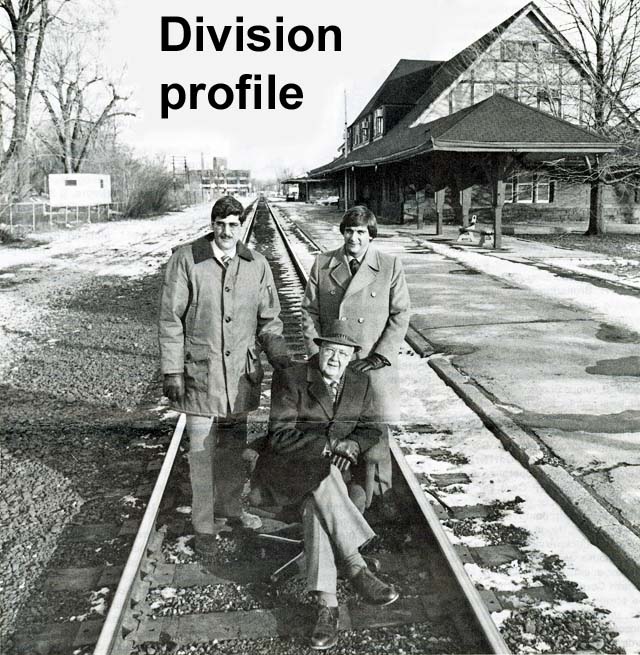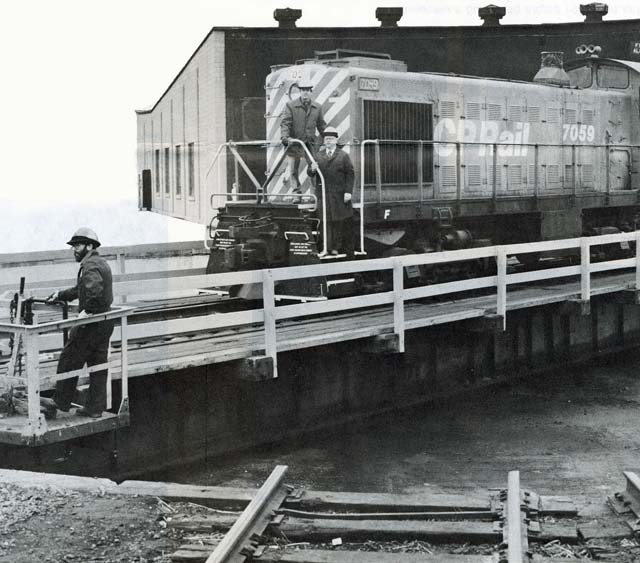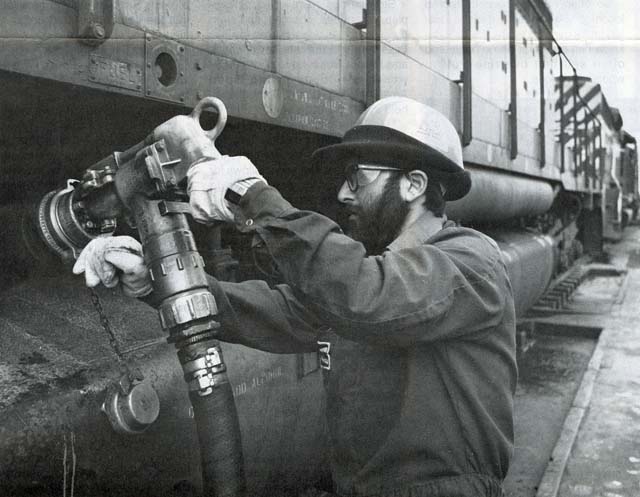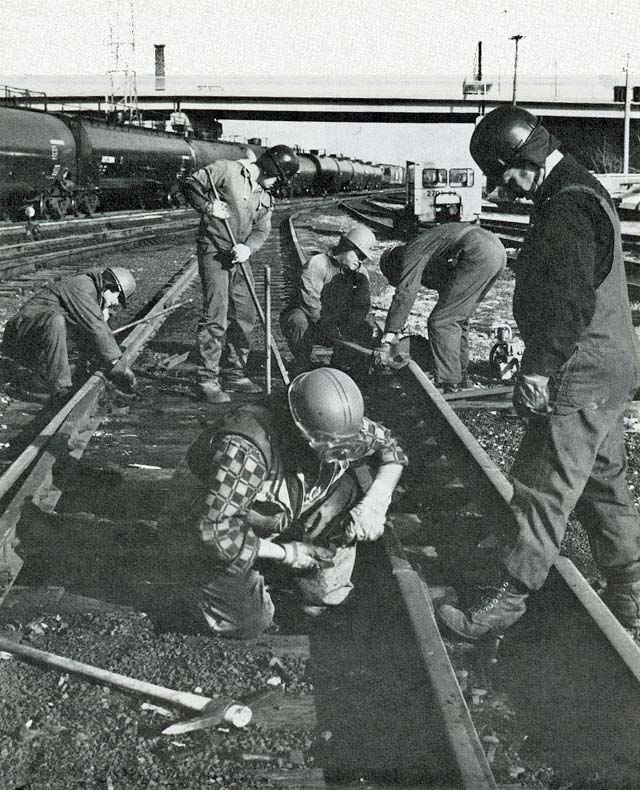|
|
Volume 13
Number 6 April 27, 1983 |

|
for Rail Traffic Toughens

London Ontario - Winding through more than 660 miles (1,062 kilometres) of Canada's industrial and agricultural heartland, CP Rail's London Division in southwestern Ontario is second largest on the Eastern Region.
The division is a vital link between Montreal/Toronto and the Windsor/Detroit gateway.
Unlike many other sections of CP Rail which were built by the company, the London Division traces its early roots to various lines absorbed into the CP Rail system during the 1880s and some as late as 1907.
Railways, such as the Ontario & Quebec, Credit Valley, Toronto Hamilton &Buffalo, St. Mary's & Western Ontario, and the Lake Erie & Pacific, reflect the intense railway construction in southwestern Ontario during that era.
Even today, CP Rail faces stiff competition for traffic from CN Rail, ConRail, Norfolk & Western, Chesapeake & Ohio, and the Detroit Toledo & Illinois which also serve the area.
Although the division is headquartered in London, a significant part of its operation is based in Windsor.
"The high volume of interchange traffic in this area is one prime reason for having the bulk of our repair and maintenance facilities here," said Larry Field, assistant superintendent, Windsor. "Although traffic was down substantially in 1982, we still handled approximately 190,000 cars through this yard."
Because a large number of cars that pass through Windsor are interchange cars, inspection procedures are extremely important.
The safety checks, known as interchange inspections, are mandatory before CP Rail will accept any traffic from other railways. If defects are detected, cars can be repaired immediately.
This is one reason CP Rail opened a car shop in Windsor in 1973.

INSPECTIONS IMPORTANT
The shop with its two service tracks, repaired approximately 11,900 freight cars in 1982. Of these, more than 8,100 were foreign-owned cars.
In addition to the car shop, the division also has a small diesel shop. "We have four stalls in the roundhouse which have service pits. This allows us to maintain the five engines assigned here as well as those in London and Chatham," said Bruce Carmichael, locomotive foreman.
"Our staff of 19 also fuel, sand, and check all main line engines to ensure we have no operational delays en-route after leaving Windsor."

But as Mr. Field notes, being an originating point can sometimes be a railroader's nightmare.
"Here, we rely a great deal on five other railways in this area feeding us traffic by a certain time so we can marshal these cars and make up eastbound CP Rail trains," explained Mr. Field. "If the weather or other unforeseen delays tie up these trains, the whole system can become disrupted."
Much of this international traffic comes to CP Rail from Detroit. The only way this traffic can link up with CP Rail is either across the Detroit River by barge or under it through a tunnel owned by ConRail.
The tunnel is the fastest link but it cannot handle high or wide loads such as multi-levels or high-cube box cars. Nor are cars carrying certain dangerous commodities permitted to travel through the tunnel.
These types of cars must be separated at a yard in Detroit and transferred to the Norfolk & Western barge. The barge service operates two shifts per day and is capable of moving four barge loads per shift.
The two larger barges can handle 24 car lengths each whereas two smaller barges each handle 22 car lengths.
From the barges, a CP Rail crew gathers the cars and transfers them to the main yard.
"The yard isn't big, holding only about 1,200 cars, therefore the only way to keep it clean of traffic is to marshal, quickly and get the trains on their way," said Mr. Field.
Approximately 100 miles (160 kilometres) east is London, headquarters for the division.
The superintendent and supporting staff are located in the CP Rail station in the heart of London. The Customer Service Centre is in a modern facility a few miles east in the freight yard.
Helping take care of customer needs on the division is Bob Platt, supervisor, CSC, a 33 year veteran of the company, who began as an operator at Trenton.
"The London Division is a little different than most others in that we are not only servicing the major industrial area of southwestern Ontario but also the rural areas such as from Lake Huron, and Georgian Bay to Lake Erie," said Mr. Platt.

APPLES AND ORANGES
"But although the areas covered are as different as apples and oranges, the one common denominator is that the customer expects reliable service."
With the recession, Mr. Platt notes that shippers are now demanding more reliability from transportation companies.
"Many companies aren't carrying large inventories, therefore, when they need a certain product, they need it fast. Our job is to show the customer that we can deliver the goods on time," he said.
REGAINING TRAFFIC
Echoing Bob's comments is Cal Timms, district manager, marketing and sales. "Competition for existing traffic is unlike I've ever seen it before. The recession has seen traffic decline almost 20 percent in 1982 over 1981."
For Mr. Timms and his staff it means a lot of hard work regaining traffic.
The first question shippers ask is how quickly can we deliver their goods. The demands from shippers for various types of service have meant people in Marketing and Sales, Customer Service, and Operations having to work very closely.
But while the bottom line is moving goods to market, the objective is to move them quickly and safely.
One look at the London Division shows that safety is more than just a poster on a wall.
The division has ranked consistently in the top five in safety standings.
"Safety here isn't taken lightly," said Keith Harvey, division accident prevention co-ordinator. "To operate efficiently you have to operate safely and that is a training process."
COMMON SENSE
Although a lot is common sense, Mr. Harvey stresses the need to use this sense at all times both on and off the job.
Mr. Harvey and other officers on the division are determined to continue reducing accidents. In 1980 the division recorded 44 lost time injuries while in 1982 there were only 12.
"The division works as a team. Everyone is looking out for his fellow worker," he said.
Superintendent George Nutkins, who began his career as a call-boy in London in 1941, summed up his division this way:
"While the rails may be held together and made strong with spikes, bolts, and welds, the railway is held together and derives its strength from people. On the London Division, our greatest asset is our people."

